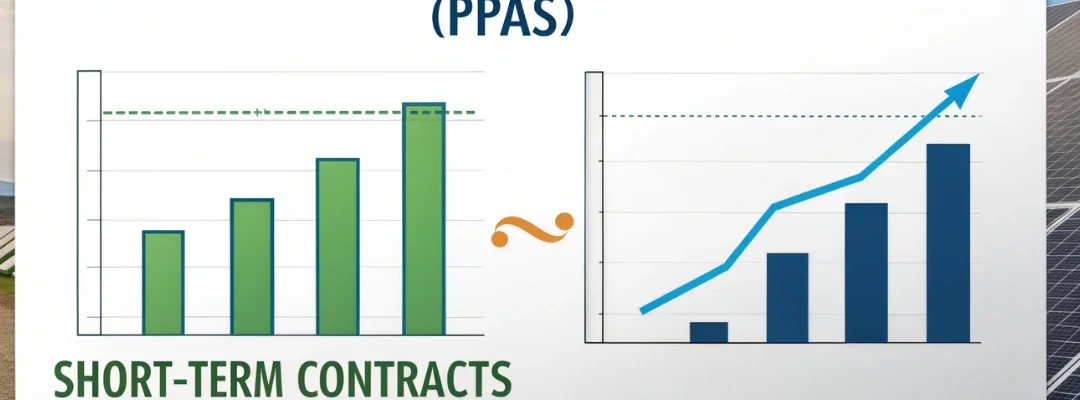Introduction
As India accelerates toward its 500 GW renewable energy goal, businesses are increasingly turning to solar energy to cut costs and meet sustainability goals.
But there’s a key question that many corporate energy buyers face:
Should we lock in a long-term Power Purchase Agreement (PPA) or opt for a short-term solar contract?
Each model comes with its own set of benefits and trade-offs — and the right choice depends on your business strategy, cash flow stability, and risk appetite.
What is a Long-Term PPA?
A long-term PPA is a contract (typically 15–25 years) where the buyer agrees to purchase solar power from a developer at a fixed tariff.
Popular in:
- Utility-scale solar projects
- Corporate and industrial procurement
- Group captive solar parks
Advantages
- Tariff Lock-in: Protection from rising electricity rates over decades
- Easier Financing: Long-term cash flow certainty makes projects bankable
- Investor Appeal: Developers and financiers prefer long-term visibility
- Sustainability Alignment: Matches RE100, net-zero, and ESG goals
Disadvantages
- Lower Flexibility: Locked into terms for 15–25 years
- Opportunity Cost: May miss out if future market tariffs drop
- Exit Penalties: Terminating early can trigger financial penalties
What is a Short-Term Solar Contract?
A short-term solar agreement (1–5 years) allows businesses to procure solar power without a long-term commitment.
Popular in:
- Open access markets
- SMEs or companies new to solar adoption
- Businesses anticipating operational changes
Advantages
- Flexibility: Easily switch developers or renegotiate terms
- Low Commitment: Good for trial runs or uncertain demand
- Speed: Faster to structure and sign
Disadvantages
- Price Instability: No protection from market volatility
- Financing Challenges: Lenders may see short-term PPAs as risky
- Not Ideal for Big Projects: Developers hesitate without long-term security
Head-to-Head Comparison: Long-Term vs. Short-Term Solar Agreements
| Factor | Long-Term PPA (15–25 yrs) | Short-Term Contract (1–5 yrs) |
|---|---|---|
| Tariff Stability | High – Fixed for decades | Low – Prone to fluctuation |
| Flexibility | Low | High – Switch anytime |
| Financing & Bankability | Strong | Weak |
| Ideal Use Case | Large corporates, solar parks | SMEs, pilot solar users |
| Risk Exposure | Low | Medium to High |
| Setup Time | Longer (due diligence) | Faster |
Real-World Case Studies
Tech Park in Bengaluru (Long-Term PPA)
- 20-year PPA at ₹4.5/unit
- Grid tariffs rose to ₹8/unit
- Annual savings: ₹12–15 crore
- Enhanced sustainability ranking for global clients
Manufacturing SME in Gujarat (Short-Term Contract)
- Chose 3-year PPA at ₹4.9/unit
- Tariff renewal jumped to ₹6.3/unit after expiry
- Net savings dropped by 40% in year four
Lesson: Long-term PPAs offer financial insulation and ESG alignment; short-term contracts provide flexibility but carry renewal risks.
When Should You Choose Which?
| Choose Long-Term PPA If… |
|---|
| You have stable energy demand over the next 10–20 years |
| You want to secure funding and lower cost of capital |
| You have RE100 or sustainability reporting mandates |
| You want to lock in predictable OPEX |
| Choose Short-Term Contract If… |
|---|
| You’re just testing solar as a new strategy |
| Your operations may relocate, expand, or scale down |
| You want rapid deployment with minimal commitment |
| You’re in a policy-uncertain state or transitioning business model |
The Future of Contract Models in Indian Solar
India’s maturing solar market is seeing:
- Hybrid models (e.g. 5-year lock-ins with renewal clauses)
- Greater adoption of open access and group captive PPAs
- State-level policies encouraging longer tenure PPAs for grid stability
- Corporate ESG mandates driving preference for long-term solar procurement
As regulations evolve and energy prices fluctuate, businesses that balance flexibility with foresight will benefit most.

